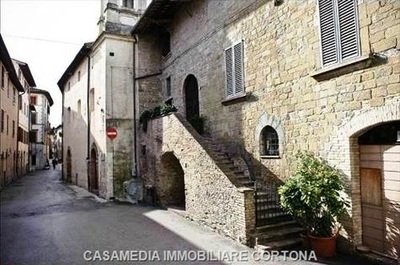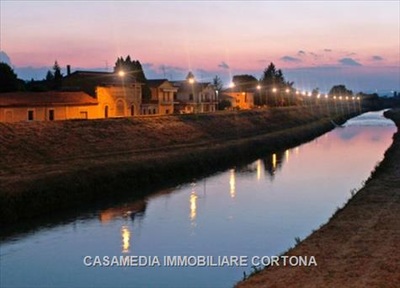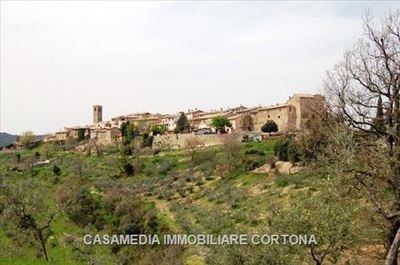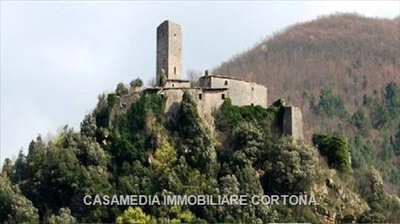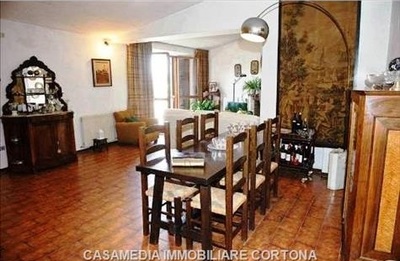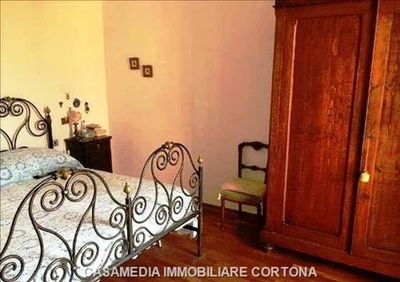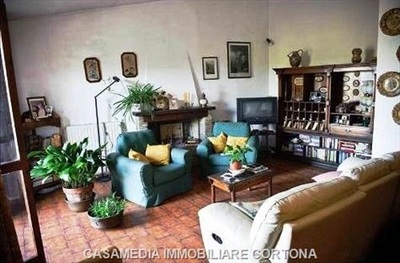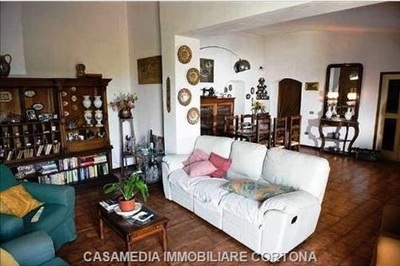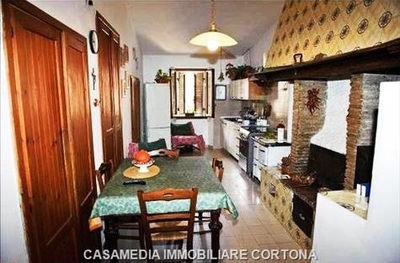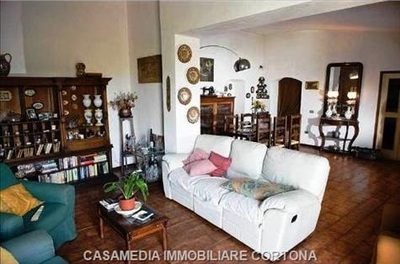Descrizione immobile
Cannara vendesi appartamento di 150 mq in pietra antica, tipica abitazione dello storico paese, composta da ampio soggiorno con camino, cucina abitabile e due ampie camere da letto più due bagni. Cannara sorge al centro della Valle Umbra e si adagia sulla riva sinistra del fiume Topino, alla confluenza del torrente Timia, ad una altitudine di circa 191 metri slm. Il territorio comunale è racchiuso tra i comuni di Assisi, Spello, Bevagna, Gualdo Cattaneo e Bettona. E' ubicata a soli 20 Km da Perugia. I primi insediamenti di questo territorio, inizialmente palustre, risalgono all'anno Mille, quando il conte Valerio Ranieri vi si stabilisce insieme ad altri nobili perugini, trovando un territorio fertile e naturalmente difeso da due corsi d'acqua. Al tempo di San Francesco (tra XII e XIII sec.) Cannara è già un castello con le sue mura, il palazzo della corte e numerose chiese. Nel 1291 il piccolo comune, gravato dalla pressione della vicina e potente Assisi, si sottomette a Perugia, dalla quale riceve in dono lo stemma del Grifo rampante e alla quale legherà la sua storia per molta parte del Medioevo. Nel 1424 Braccio Fortebraccio da Montone concede la signoria di Cannara a Malatesta Baglioni, che i suoi discendenti, non senza interruzioni, terranno fino al 1648, quando il piccolo paese torna ad essere integrato nello Stato della Chiesa senza più intermediari principeschi. Sulla collina troviamo il centro medievale di Collemancio, nei pressi del quale sorge l'unica area archeologica della Valle Umbra: Urvinum Hortense (citata da Plinio il Vecchio e Strabone). Questa zona è interessata da alcune campagne di scavi che hanno portato alla luce una discreta quantità di reperti, visibili presso l'Antiquarium, e il famoso Mosaico delle terme.Nel territorio cannarese e grave; possibile individuare testimonianze significative della presenza si S. Francesco d'Assisi: la Predica agli uccelli a piandarca, il Sacro Tugurio e l'istituzione del Terz'ordine Francescano. E' possibile visitare inoltre molte chiese, tra cui ricordiamo quella di S. Biagio, in stile romanico, risalente al secolo XIII, quella di S. Giovanni Battista del XV-XVI secolo al cui interno si trova una tavola di Niccolò di Liberatore detto l'Alunno e quella delle Sacre Stimmate dove è possibile vedere un crocifisso del XV secolo utilizzato il venerdì santo per la Processione del Cristo Morto.
Cannara sale of 150 square meters of ancient stone, typical house of the historical village, composed large living room, kitchen and two large bedrooms and two bathrooms.The city of Cannara is located in the center of the Umbrian Valley and lies on the left bank of the river Mouse, at the confluence of Timia stream, at an altitude of about 191 meters above sea level. The district is surrounded by the towns of Assisi, Spello, Bevagna, Gualdo Cattaneo and Bettona. And 'it situated just 20 km from Perugia. The first settlements in this area, originally marshland, back to the year one thousand, when the Count Valerio Ranieri settled there along with other nobles from Perugia, finding a fertile territory and naturally defended by two rivers. At the time of St. Francis (between XII and XIII century.) Cannara is already a castle with its walls, the palace of the court and numerous churches. In 1291 the small town, burdened by the pressure of the neighboring and powerful Assisi, Perugia submits to, and receiving the gift of the coat of arms of the Griffin rampant and which linked its history to a large part of the Middle Ages. In 1424 Braccio Fortebraccio da Montone grants the lordship of Cannara Malatesta Baglioni, that his descendants, not without interruptions, held until 1648, when the small country becomes integrated in the State of the Church no longer princely intermediaries.On the hill there is the medieval center of Collemancio, near which is the only archaeological site of the Valle Umbra: Urvinum Hortense (mentioned by Pliny the Elder and Strabo). This area is affected by some excavations that have brought to light a fair amount of exhibits, on display at the Antiquarium, and the famous mosaic of the spa.In the territory of Cannara you can find significant evidence of the presence St. Francis of Assisi Preaching to the Birds to Piandarca, the Sacred Hovel and the establishment of the Franciscan Third Order. It 'also possible to visit many churches, among which that of S. Biagio, in Romanesque style, dating from the thirteenth century, that of St. John the Baptist of the fifteenth and sixteenth centuries in which there is a painting by Niccolò di Liberatore said the 'pupil" and that of the Sacred Stigmata where on Good Friday for the procession of the dead Christ a fifteenth-century crucifix you can see used.
Dove si trova
Regione: Umbria
Provincia: Perugia
Comune: Cannara
Superficie (M.q.)
150
Prezzo richiesto
150.000 €
Condizioni
Vendita
Cannara sale of 150 square meters of ancient stone, typical house of the historical village, composed large living room, kitchen and two large bedrooms and two bathrooms.The city of Cannara is located in the center of the Umbrian Valley and lies on the left bank of the river Mouse, at the confluence of Timia stream, at an altitude of about 191 meters above sea level. The district is surrounded by the towns of Assisi, Spello, Bevagna, Gualdo Cattaneo and Bettona. And 'it situated just 20 km from Perugia. The first settlements in this area, originally marshland, back to the year one thousand, when the Count Valerio Ranieri settled there along with other nobles from Perugia, finding a fertile territory and naturally defended by two rivers. At the time of St. Francis (between XII and XIII century.) Cannara is already a castle with its walls, the palace of the court and numerous churches. In 1291 the small town, burdened by the pressure of the neighboring and powerful Assisi, Perugia submits to, and receiving the gift of the coat of arms of the Griffin rampant and which linked its history to a large part of the Middle Ages. In 1424 Braccio Fortebraccio da Montone grants the lordship of Cannara Malatesta Baglioni, that his descendants, not without interruptions, held until 1648, when the small country becomes integrated in the State of the Church no longer princely intermediaries.On the hill there is the medieval center of Collemancio, near which is the only archaeological site of the Valle Umbra: Urvinum Hortense (mentioned by Pliny the Elder and Strabo). This area is affected by some excavations that have brought to light a fair amount of exhibits, on display at the Antiquarium, and the famous mosaic of the spa.In the territory of Cannara you can find significant evidence of the presence St. Francis of Assisi Preaching to the Birds to Piandarca, the Sacred Hovel and the establishment of the Franciscan Third Order. It 'also possible to visit many churches, among which that of S. Biagio, in Romanesque style, dating from the thirteenth century, that of St. John the Baptist of the fifteenth and sixteenth centuries in which there is a painting by Niccolò di Liberatore said the 'pupil" and that of the Sacred Stigmata where on Good Friday for the procession of the dead Christ a fifteenth-century crucifix you can see used.
Dove si trova
Regione: Umbria
Provincia: Perugia
Comune: Cannara
Superficie (M.q.)
150
Prezzo richiesto
150.000 €
Condizioni
Vendita

